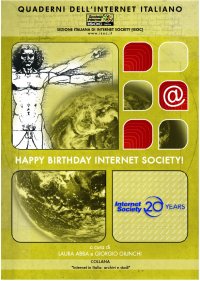- Italy's
contribution to the founding of ISOC took the form of two organizational
members:
- CNUCE,
part of CNR, the state research body,
- CNAF,
part of the National Institute for Nuclear Physics.
- This is
not the place for even an outline of the story of information technologies
in Italy, but the reader should at least be aware of the main events in
one of its most important phases: the following events explain why two
teams were involved, the network of CNR engineers and network of INFN physicists.
- The big
bang of Italian IT and its local know-how took off after the war in the
context of a classic fundamental debate [NB: unconcluded… the debate goes
on] on strategies for acquiring prototypes of international operational
research.
- The terms
of the debate were succinctly summarized [1952] by the brilliant mathematician
Bruno De Finetti: "[...] The unanimous
opinion of those who were knowledgeable about the situation in Italy and
heard we wanted to "make or buy" a machine for INAC (without
being asked their opinion) was the exclamation: "Build!, You must
build your computer yourselves [...] ".
- Make or
buy?
- In the
space of a few months [1955] the University of Milan and the National Institute
for Calculation Applications in Rome bought a CRC 102A and a Ferranti,
respectively.
- Make or
buy?
- At the
same time Pisa, with a centuries old legacy in machinery construction chose
the other route: construction of the first commercial Italian computing
machine began [the Elea 9000, at the Olivetti factory in Barbaricina],
under the leadership of Adriano Olivetti.
- Construction
also began on the first Italian scientific calculator [the Pisan Electronic
Calculator, at the University of Pisa], following the suggestion by Enrico
Fermi to the rector of his alma mater: "[...]
If asked about the various possible uses of such a sum, construction in
Pisa of an electronic calculating machine seems to me to be far and away
the best. It would be a research tool greatly to the benefit, almost immeasurably
so, of all the sciences and the world of research [... ]"
- In a few
years the "ragazzi di Via Panisperna" (the address of institute
of physics at the university of Rome, [and students of Fermi] who remained
in Italy had re-established an Italian school of nuclear physics: the INFN,
which in the mid 50s began construction of the first Italian accelerator,
the electron synchroton in Frascati.
- The experiments
carried out in Frascati created a need for automatic calculation: so it
is easy to see why the INFN actively supported, with its own personnel
on site, the project team and development of the C.E.P. in Pisa [as was
also the case with Olivetti ...].
- On completion
of the project in Pisa, and bringing the project to a new generation and
a new market for calculating machines, a key figure in the team [and director
of many films on Italian ICT], Alessandro Faedo who had become rector of
the university, set up the Centro Nazionale Universitario di Calcolo Elettronico
- CNUCE - which he later incorporated into CNR when he became its Chairman.
- CNR-CNUCE
then had to tackle an unending series of calculation and IT services and
develop the Internet prototype matrix, ARPAnet, which its Networks Service
implemented, one of the first in the world, in the 1980s.
- At the
same time CNR-CNUCE began to share the INFN network's vision of harmonizing
a national network for academic and research groups: GARR,
which is now, to put it simply, the Italian state-of-the-art network.
- At the
end of the '90s, in a way which still today is worth reflecting on, CNUCE
was shut down and its department of Telematic Applications (RAT) became
the Institute of Telematic Applications (IAT) of CNR. This later became
the Institute of Informatics and Telematics (IIT).
- However,
the original prestigious affiliation to ISOC, signed by Stefano Trumpy
in 1992, has been kept till today throughout the various institutional
changes and directorships: Franco Denoth, Enrico Gregori, Domenico Laforenza.
- I hope
this has simplified somewhat for the reader the complex route that led
INFN directly and CNR-CNUCE indirectly to the origins of a national computing
facility, and from there jointly to the birth of a national IT network,
and later naturally joining forces again to assist in international co-ordination
of the Internet: the Internet Society.
- This section
on Italy and the ISOC is based on notes by the celebrated directors of
CNR-CNUCE and INFN-CNAF: Stefano Trumpy and Enzo Valente.
|
![]()
![]()
![]()
